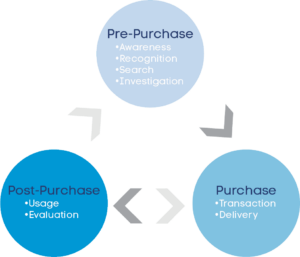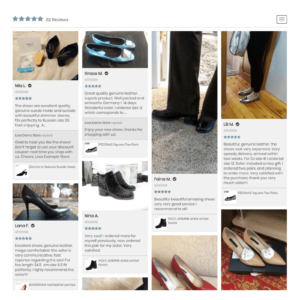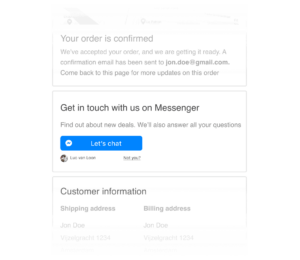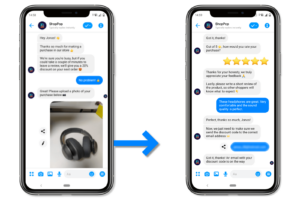Insights
Guest post: How chat marketing can deliver a rich customer experience
Caitlin Telford
Published: February 19, 2021
The importance of the customer journey’s post-purchase stage is too often underestimated.
But good customer aftercare is not only essential, it’s the way to minimise returns, generate reviews, increase customer loyalty, stimulate recurring purchases and build your brand. Start chat conversations from your checkout page or packaging inserts.
Use chat to facilitate evaluation, support, order updates, upselling/cross-selling and marketing towards new sales opportunities. After all, chat is cheap, beats email and SMS at every benchmark – and who calls on phones these days, anyway?
This article will cover:
- What the post-purchase stage of the customer journey is
- Why improving the post-purchase experience drives customer experience (CX)
- How decreasing post-purchase dissonance boosts customer loyalty
- How to use chat in your post-purchase CX
- Examples of using chat in the final stage of the customer experience.
Let’s dive right in.
What is the post-purchase stage of the customer journey?
Most e-commerce businesses focus mostly on the pre-purchase stages of the customer journey. They build awareness for their brand, influence consideration by taking away concerns and objections, until a purchase is made.
To turn a customer into a recurring customer and increase their customer lifetime value (CLV), it’s equally important to optimise the post-purchase stage of the customer journey. This means ensuring smooth and effortless delivery, impeccable product quality, and top-notch customer support. These things, together, create customers loyal to your brand.
Customer acquisition costs vs. retention
A question you should ask yourself is: what are the costs associated with getting people to buy my products, i.e. what are the customer acquisition costs (CAC)?
Next question, then, should be: what are the costs associated with getting people to buy my products again, and refer my business to others, i.e. what are the costs of retention (repeat purchases and advocacy).
In general, you’ll find that it’s cheaper to turn happy customers into returning customers and brand ambassadors, than it is to acquire new customers. Research shows that it’s actually 7 times more expensive to get a new customer than it is to retain an existing one. This is the reason you should focus on optimising your post-purchase customer experience.
Optimising the brand loyalty loop
The positive memories of the buying experience can greatly influence a consumer’s future buying decisions. The post-purchase experience plays a key role in what is known as the brand loyalty loop. When customers try a product and are pleased with the post-purchase experience, they are:
- More likely to leave a positive review (social proof)
- More likely to tell their friends about their positive experience (brand ambassadors)
- Ultimately more likely to make more purchases (returning customers)
All of these contribute to more revenue and success for your business.
The importance of two-way communication
Sure, sending transactional emails like order confirmations and shipping updates are essential to any e-commerce business. But when it comes to communication with your customers, these are somewhat of a one-way street. You’re talking at your customers, instead of communicating with them.
Especially when making online purchases, as opposed to in a brick-and-mortar shop, consumers are a little more nervous about who it is that they are buying from, exactly. Using chat apps to communicate with these customers helps you come across as personal. You’ll find it much easier to build relationships on messaging apps.
Here are some statistics to consider:
- 61% of people say messaging is the easiest, most convenient way to contact a business
- 63% of people across generations prefer to message than call or email
- More than half of people say messaging a business makes them feel more personally connected to a brand.
Besides, when it comes to ROI, chat also outperforms email at every benchmark, with open rates often averaging at 80%.
Why improving the post-purchase experience drives CX
Customer experience (CX) optimisation is all about improving customer satisfaction and loyalty. Customer experience management is:
“The practice of designing and reacting to customer interactions to meet or exceed customer expectations and, thus, increase customer satisfaction, loyalty and advocacy.”
Most of the pre-purchase stage of the buyer journey focuses on creating customer expectations. Sales and marketing efforts set short term goals of driving website traffic and converting this into sales.
For long-term growth, it’s important to meet or exceed the expectations set in the pre-purchase stage of the buyer journey. This is a continuous process of optimisation in which customer feedback gathered in the post-purchase stage is invaluable.
The importance of your customer feedback loop
To increase revenue through repeat purchases, gather social proof in the form of reviews and get more word of mouth referrals, you need to get in touch with your customers. Find out what they liked about the buying process. Use their feedback to improve your processes.
You get this feedback by engaging customers directly, whether through email campaigns or more low-threshold alternatives like chat messaging. Getting as much feedback as possible helps you keep full control over your CX.
Less post-purchase dissonance increases customer loyalty
The worst thing that can happen to your e-commerce business is your customers regretting their purchase. There are several reasons for post-purchase dissonance or ‘buyer’s remorse’:
- Customers think they overpaid for the product they purchased
- Customers realise that a competitor’s product is better
- There’s a disparity between prior evaluation of the product and final purchase
- Customers regret impulse purchases.
Ways to minimise post-purchase dissonance
One of the best ways to minimise post-purchase dissonance is to offer seamless communication. Especially in e-commerce, customers are likely to regret impulse purchases. A purchase online is made at the click of a button, after all, while the gratification of holding the product in their hands might take a while.
To minimise post-purchase dissonance it’s essential that your business:
- Offers clear pre-purchase communication about what customers can expect
- Has generous warranty, exchange and return policies
- Makes sure shipping info is readily available, clear and up to date
- Inspires consumer confidence by opening a direct channel of communication
Again, these tactics all increase customer loyalty to your brand, and with it overall CLV. If you focus on retaining existing customers, you’ll spend way less on acquiring new ones.
The 2020 e-commerce boom has most likely seen your competition and your CAC spike, meaning a focus on retention is now more important than ever.
How to incorporate chat in your post-purchase CX
There are several ways you can start post-purchase chat conversations with your customers. Here are some touchpoints you can consider to start chatting with customers.
Checkout pages
The earlier the better, of course – it’s a good idea to start with the very first post-purchase touchpoint: your checkout page.
If your store runs on Shopify, consider adding a post-purchase chat widget to your checkout pages. This allows customers to immediately get in touch with your business on Messenger at the click of a button.
Confirmation emails
Sure, customers could simply reply to your confirmation email – but there’s a vast difference between a more formal channel for communication like email and chatting with a business.
Add a button to your confirmation emails that links out to one of your chat apps to open an immediate and direct channel for support.
Chat app usage varies quite strongly per region, so take this into account. Does your clientele use Messenger, mostly? A simple m.me link will send people straight to your business on Messenger. Since European audiences generally prefer WhatsApp, adding a special WhatsApp smart link to your emails will do the trick.
Product unboxing moment
The unboxing touchpoint is another great moment to start two-way communication. Use QR codes on package insertions or print these on the packaging itself. Remember: the product unboxing experience is one of the happiest moments in the customer journey. Make the most of that happiness, since this is also the best time to ask for a product review.
Get the conversation going by offering an incentive, like a small discount if people leave a review in chat. Make it clear that you also offer support through chat. Inspire confidence and pre-empt support questions to minimise returns.
Examples of using chat in the final stage of the customer experience
Here are a few examples of what you can use chat conversations for in the post-purchase stage of the customer journey:
- Evaluation (generating product reviews). Use QR code links to a chat flow in which you ask customers to leave a photo review. Negotiate this in a chat conversation like you would have with friends and family. Better yet: automate it using a chat marketing platform like ShopPop
- Support (handling incoming queries pro-actively). Respond to support requests as soon as possible to minimise returns. Make sure people know your business is available to chat
- Order delivery updates (sending receipts, shipping updates). Keep in touch with your customers throughout the delivery process and answer questions as they arise. Give them peace of mind about their purchase to inspire brand loyalty
- Upselling/cross-selling (personalised product recommendations). While you’re chatting to your customers, you might as well upsell and cross-sell products. Conversational commerce is personal and efficient
- Post-purchase marketing (opt-ins to sale alerts/product drops). Send your customers a receipt and ask them if they’d like to opt in to a DM alert when your next sale goes live. This form of consent-based marketing at the perfect touchpoint makes more sense than unsolicited marketing emails.
These are just a few of the examples of what you can do using chat conversations. Feel free to get in touch and let us know how you would go about starting the conversation and making the most of post-purchase CX using chat.
About the author
Jonas van de Poel is Head of Content and Community at ShopPop, the all-in-one chat marketing app that helps merchants reach their audiences directly on messaging apps.
Based in Amsterdam, he loves all things copywriting and content marketing. Find him on LinkedIn.




